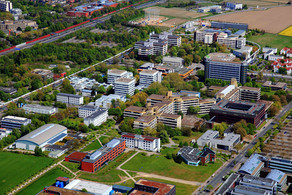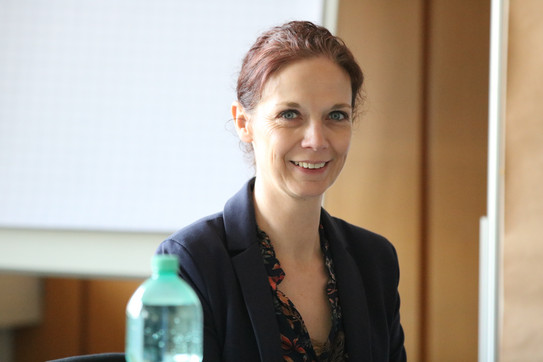Prepared for a cool future
- TU News
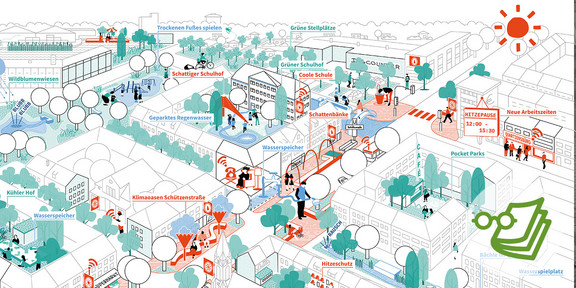
Summers are getting hotter, heavy rain and storms are also raging in cities - as the floods in Germany, Belgium and Austria in July have currently shown. The interdisciplinary project "iResilience" led by the Social Research Center of TU Dortmund University (sfs) is looking into the question of how people can prepare themselves for the increasingly extreme conditions.
The consequences of climate change are particularly severe in cities. Dense development, sparse greenery and sealed surfaces can offer little in the way of resistance to heat and water masses. This was made clear in the summer of 2021 by depression "Bernd," which caused severe flash floods and inundations, particularly in North Rhine-Westphalia and Rhineland-Palatinate, but also in other parts of Germany and Europe. Numerous houses, bridges and roads were destroyed or damaged, and more than 180 people lost their lives in Germany.
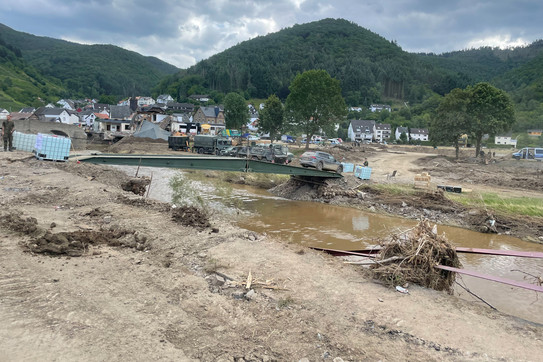
Increasing climate resilience
The strategies people can nevertheless use to arm themselves against the challenges of climate change are being investigated by a collaborative project launched in 2018 under the leadership of the Social Research Center at TU Dortmund University. Led by Stephanie Bund, sfs is working with the cities of Dortmund and Cologne to develop and test new practices and technologies to improve urban climate-adapted resilience: resilience.
The project "iResilience - Social Innovations and Smart Urban Infrastructures for the Resilient City of the Future," funded by the German Federal Ministry of Education and Research, focuses primarily on three topics: heat prevention, flood prevention and the promotion of urban greenery. Measures are to be developed and tested that complement the diverse concepts of the cities in Dortmund and Cologne and with whose help the climate resilience of the cities can be strengthened - in a sustainable and environmentally compatible manner. In this way, the quality of life in urban neighborhoods is to increase at the same time.
New approaches are being tested in three real laboratories
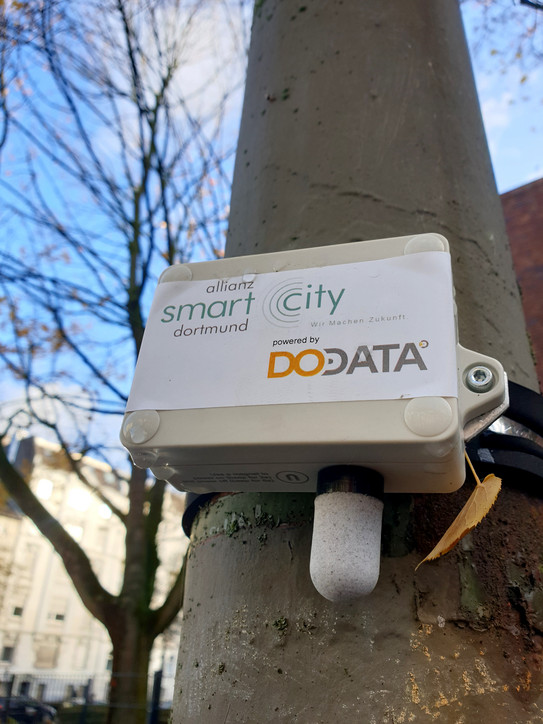
As part of the project, inconspicuous boxes on lampposts in Dortmund's harbor district become part of something big: how people deal with stressful climate conditions such as heat, heavy rain and drought. Stephanie Bund: "It's all about anticipatory adaptation. We want to find out what technical solutions combined with often small behavioral changes can do, and what each individual can do." The issue of climate change affects everyone, she said, and the effects have many dimensions.
Dortmund's habour district is one of three research quarters. There, 30 sensors have been installed on street lamps to measure temperature and humidity. The data is sent by radio to a municipal platform and is intended to be a contribution to the "Smart City Dortmund" in the future. The continuous evaluation of the measurement data makes it possible to create daily climate maps. On particularly hot days, citizens could be warned in the future and advised of shadier routes through the neighborhood.
In addition to the city center north, the Jungferntal as the second Dortmund location as well as Cologne-Deutz belong to the real laboratories of "iResilience". In these pilot districts, new forms of cooperation between science, practice and other relevant actors are being tested. The participants learn from each other and thus initiate social change. In all three neighborhoods, administration and science are working together with citizens on the climate issue. The aim is to combine heat and flood prevention with a livable residential environment in the long term.
The project cities of Cologne and Dortmund each have one full-time employee working on the "iResilience" project, financed from the funding, and also act as an interface to municipal departments such as the environmental office and the municipal drainage companies and to the Dortmund "nordwärts" project. The Institute for Energy Systems, Energy Efficiency and Energy Economics ie³ at TU Dortmund University is also on board, as are the German Institute of Urban Affairs (Difu) as co-coordinator of the reallaboratory processes in Cologne, the Research Institute for Water and Waste Management at RWTH Aachen University and the Department of Architecture and Landscape at HafenCity University Hamburg as partners for urban green space. An engineering firm complements the team for specialist planning issues. "We are not starting from scratch," says Stephanie Bund, "and we are a very interdisciplinary team that supports the neighborhoods with expertise and methods, moderates novel formats, and promotes communication between the stakeholders. That's what sets the project apart."
New forms of cooperation
In order to better solve the problems associated with climate change, the project starts with the people. Social innovations are mentioned in the goal description. Behind the abstract term are people from very different areas who are working together in new ways. Municipal administration, neighborhood management, housing cooperatives as well as tradespeople and homeowners are networking and developing activities and solutions together. This results in new forms of collaboration and many small building blocks - such as greening a backyard, making one's own basement flood-proof, or using shaded walkways on hot days - that help build resilience.
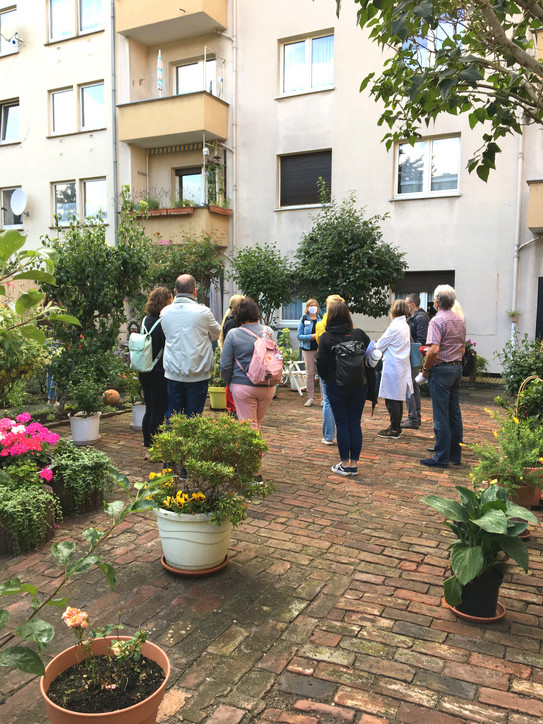
But digital innovations should also help improve the situation. This is where, for example, the sensors installed in Dortmund's Nordstadt district in February 2021 come into play. Via an app that is currently being developed, the measurement data fed in can inform citizens about how hot it is at a particular location. At the same time, users can feed in information to determine the perceived temperature in more detail. This measure aims to prevent the number of heat-related deaths from increasing in the future as a result of demographic change. Vulnerable groups are warned in good time of stressful temperatures and provided with alternative routes.
Stephanie Bund believes that too little attention has been paid to the issue of heat prevention by the general public. The project aims to raise awareness, for example in senior citizens' homes. "Often it's about small things, such as how much water to drink on hot days." The app is intended to be an element in countering the problematic consequences of climate change through optimal availability of climate and precautionary information.
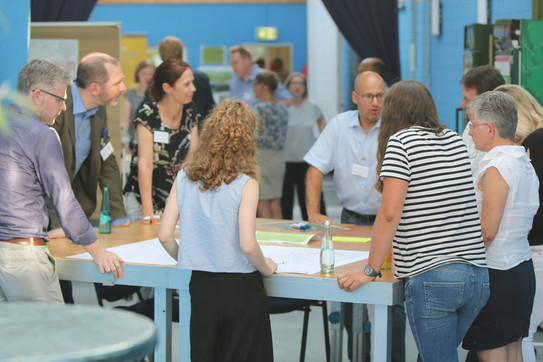
"Those who live locally know more".
The "iResilience" project team acts as a moderator. It supports the pilot neighborhoods with expertise and methodological knowledge, initiates local action groups, and accompanies and documents events that deal specifically with certain topics. The team helps homeowners who want to unseal and plant their backyards to sit down with representatives of the city and neighborhood management and consider what is possible and what funding might be available. "The example shows that our issues are connected: More greenery makes for a better microclimate and better heat prevention, and at the same time it creates less waterlogging."
Around 50 interested people took part in the launch event in summer 2019. Since then, the team has organized several events with different focuses, some of which were held in digital form due to the Corona pandemic. Input comes from experts, then ideas are developed further, together with the residents*. Stephanie Bund: "Those who live locally know more." The project team brings all the players to the table and steers the process.
In the harbour district alone, the participants gathered 170 ideas. This resulted in a picture of the future (see article image above), which is put up for virtual discussion and further developed. As a result, a vision is growing of what a climate-robust neighborhood could look like in 2040. The graphic representation shows a green schoolyard, wildflower meadows, redesigned backyards, rainwater storage for all residents and many examples of urban gardening such as pocket parks.
Roadmap helps with implementation
A roadmap is developed from this vision, a kind of roadmap to the goal of a climate-robust neighborhood. In each of the three pilot neighborhoods, a framework plan is thus developed that can be used as a guide for implementation following the research project. "We are laying the groundwork for this. But we're not going into the backyards with the excavator ourselves," says Bund.
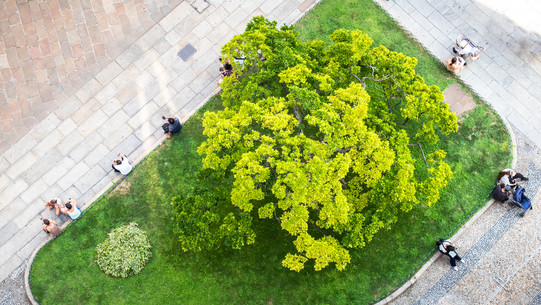
New types of cooperation are what make this project special. It networks various agencies and offices in order to get things off the ground together. The city's project staff play an important role in coordinating the project. If, for example, trees are to be planted in a street that is particularly exposed to heat, the project members can clarify the costs, financing and feasibility with the responsible parties in a short time.
An important area of research activity relates to the topic of heavy rainfall. In recent years, such events with flooding of streets and basements have increased and caused great damage. Cities, counties and regions created digital heavy rain hazard maps. Regions in the model cities of Cologne and Dortmund are also in the red zone. "iResilience" wants to draw attention to this. After all, the best hazard map is of no use if no one knows it or can read it properly.
Local action groups
Events then highlight what can be done collectively and by each and every individual to protect their home or belongings. This is how the idea of a basement action group came about, which focuses on danger spots and presents protective measures. A homeowner can show how a backwater can be prevented during heavy rainfall by simple measures such as an overflow flap. It turns out that even simple tips can help a lot: Move shelves higher, rethink the use of lower-lying rooms, don't store important documents or things on the floor.
The researchers want to work with local action groups to find and try out new formats. Behavior change and digital development work together, as with the heat app. Stephanie Bund finds it exciting to get people excited about this important topic, having joined the Social Research Center five and a half years ago with a project on the energy transition. Many small-scale issues have to be put into the context of the city, that's the challenge. The networking with all important actors, supported by a full position in each of the pilot cities, makes the project so promising for her.
The strategies tested, as well as the social and digital innovations, should be transferable to other municipalities and make them more resilient for the future.
Text: Susanne Riese
About the person
Stephanie Bund has been a research associate in the research area "Transformative Governance in Cities and Regions" at the Social Research Center (sfs) of the Faculty of Social Sciences at TU Dortmund University since 2015. Since 2018, she has also held a lectureship at the Faculty of Spatial Planning.
Stephanie Bund holds a degree in environmental science and did her master's in regional management and economic development in Göttingen. Until 2014, she worked at the Department of Geography, AG European Regional Studies as well as Cultural Geography at Saarland University.
Her work focuses on social innovation in the areas of sustainable development, energy transition, and regional climate impact adaptation. Since 2018, Stephanie Bund has been coordinating the BMBF joint project "iResilience", among others.

